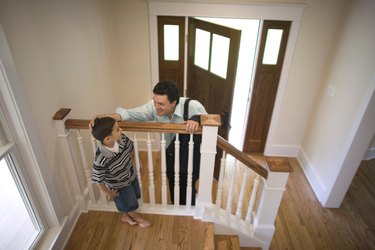
Split-level houses have living room and kitchen space on a lower level, with bedrooms and accompanying bathrooms on a higher level. The higher level usually sits directly over a basement. The basement is somewhat raised above ground level. The living room floor is halfway between the floor and ceiling of the other part of the house.
Predictable Basement Space
Video of the Day
A split-level home typically has only half of a basement. However, it's possible to have basement space under the lower level as well. Raising the second level invariably creates room below the bedrooms for a basement or other rooms.
Video of the Day
Unique Building Challenges
Soil and rock issues affect basement construction. In some cases, a split-level house may have a basement created for the look of the house -- but with no practical use. A large, obtrusive rock formation can affect digging a full basement in any part of the house. A split-level might be built to have curbside appeal with no usable basement space. However, this is a not a typical situation.
Sizable Family Area
A family room usually is the main focus of a split-level home's basement. Access to the space under second-level bedrooms is via a full staircase. The square footage at the bottom of the stairs makes a sizable space for a family room. Sometimes, a laundry room or storage space may fit there.
Different Basement Levels
Multiple levels affect the choices for builders. Not having a full-size basement space in one enclosed section limits how basement space is used. It's difficult to connect two different basement levels on a limited budget. The logistics of building a unique basement space makes this too time intensive and labor intensive for most pre-built homes. A custom house may have two or more basement levels, however, if the construction budget is generous.
Usual House Layout
The standard split-level of the 1960s and early '70s fits a predictable floor plan. You enter the home on the lower level from a porch area. The foyer inside leads to a living room, kitchen and downstairs bathroom. A deck or patio often is built next to the kitchen. In a small hallway near the front foyer, four or five steps lead up to three or four bedrooms with one or two baths. The basement is accessed from a door in the kitchen leading down to a family room/storage area.
Typical Curbside Facade
Windows at the home's front give away the basement below. You typically see small windows near ground level that align with upper bedroom windows. The window placement indicates real living space below grade, which is the family room area. The main living area usually has a large picture window if the home has the same facade as its original construction.
- MSN Real Estate; 4 Reasons People Hate Split Levels -- and How to Fix 'Em; Christopher Solomon
- SplitLevel.net: Making the Most of Your Split Level Home
- Remodel or Move: Split Level House Renovations
- Build Your Own House: Basement Construction Cost
- Architectural Designs: Split Level House Plans
- Renter's Insurance: Renting a Split Level House